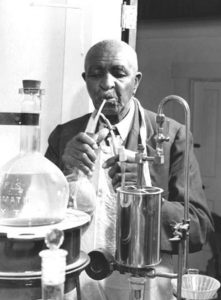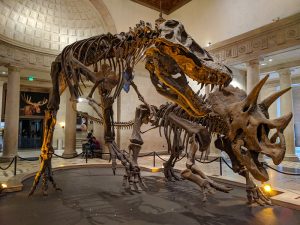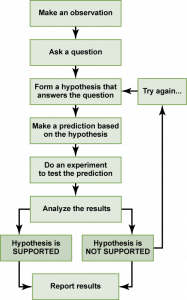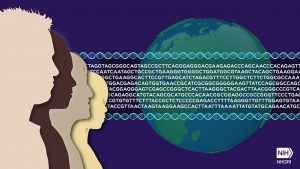1 Thinking Like a Scientist
Learning Objectives
After studying this chapter, you should be able to:
- Identify the shared characteristics of the natural sciences
- Compare inductive reasoning with deductive reasoning
- Illustrate the steps in the scientific method
- Explain how to design a controlled experiment
- Describe the goals of descriptive science and hypothesis-based science
- Apply the Claim-Evidence-Reasoning process to a scientific investigation
The Nature of Science
Environmental science (also known as environmental biology) is a field of study that focuses on the earth and its many complex systems. It is an interdisciplinary field that brings together elements of biology, geology, chemistry, and other natural sciences. It may even include elements of social sciences such as economics and political science. The discoveries of environmental science are made by a community of researchers who work individually and together using agreed-on methods. In this sense, environmental science, like all sciences, is a social enterprise like politics or the arts. The methods of science include careful observation, record keeping, logical and mathematical reasoning, experimentation, and submitting conclusions to the scrutiny of others. Science also requires considerable imagination and creativity; a well-designed experiment is commonly described as elegant, or beautiful. Like politics, science has considerable practical implications, and some science is dedicated to practical applications, such as improvements to farming practices (Figure 1). Other science proceeds largely motivated by curiosity. Whatever its goal, there is no doubt that science has transformed human existence and will continue to do so.

What exactly is science? What does the study of environmental science share with other scientific disciplines? Science (from the Latin scientia, meaning “knowledge”) can be defined as knowledge about the natural world. But science is not just a collection of facts and theories, it is also a process used to gain that knowledge.
Science is a very specific way of learning, or knowing, about the world. The history of the past 500 years demonstrates that science is a very powerful way of knowing about the world; it is largely responsible for the technological revolutions that have taken place during this time. There are however, areas of knowledge and human experience that the methods of science cannot be applied to. These include such things as answering purely moral questions, aesthetic questions, or what can be generally categorized as spiritual questions. Science cannot investigate these areas because they are outside the realm of material phenomena, the phenomena of matter and energy, and cannot be observed and measured.
The scientific method is a method of research with defined steps that include experiments and careful observation. The steps of the scientific method will be examined in detail later, but one of the most important aspects of this method is the testing of hypotheses. A hypothesis is a suggested explanation for an event, which can be tested. Hypotheses, or tentative explanations, are generally produced within the context of a scientific theory. A scientific theory is a generally accepted, thoroughly tested, and confirmed explanation for a set of observations or phenomena. Scientific theory is the foundation of scientific knowledge. In addition, in many scientific disciplines (less so in biology) there are scientific laws, often expressed in mathematical formulas, which describe how elements of nature will behave under certain specific conditions.
A common misconception is that a hypothesis is elevated to the level of theory after being confirmed, then a theory is promoted to a scientific law after it is confirmed. However, there is no evolution of hypotheses through theories to laws as if they represent some increase in certainty about the world. Hypotheses are the day-to-day material that scientists work with and they are developed within the context of theories. You can think of theories as being “bigger” than hypotheses because a theory incorporates many hypotheses and facts. Laws, on the other hand, are concise descriptions of natural events that can usually be described mathematically. For example, Newton’s Law of Gravity explains how objects in the universe attract other objects differently depending on their mass.
Natural Sciences
What would you expect to see in a museum of natural sciences? Frogs? Plants? Dinosaur skeletons? Exhibits about how the brain functions? A planetarium? Gems and minerals? Or maybe all of the above? Science includes such diverse fields as astronomy, biology, computer sciences, geology, logic, physics, chemistry, and mathematics. However, those fields of science related to the physical world and its phenomena and processes are considered natural sciences. Thus, a museum of natural sciences might contain any of the items listed above (Figure 2).

There is no complete agreement when it comes to defining what the natural sciences include. For some experts, the natural sciences are astronomy, biology, chemistry, earth science, and physics. Other scholars choose to divide natural sciences into life sciences, which study living things and include biology, and physical sciences, which study nonliving matter and include astronomy, physics, and chemistry. Some disciplines such as biophysics and biochemistry build on two sciences and are interdisciplinary.
Knowledge Check
Scientific Inquiry
One thing is common to all forms of science: an ultimate goal “to know.” Curiosity and inquiry are the driving forces for the development of science. Scientists seek to understand the world and the way it operates by using one of two main pathways of scientific study: descriptive science and hypothesis-based science. Descriptive (or discovery) science aims to observe, explore, and discover, while hypothesis-based science begins with a specific question or problem and a potential answer or solution that can be tested. The boundary between these two forms of study is often blurred, because most scientific endeavors combine both approaches. Observations lead to questions, questions lead to forming a hypothesis as a possible answer to those questions, and then the hypothesis is tested. Thus, descriptive science and hypothesis-based science are in continuous dialogue.
Knowledge Check
Hypothesis Testing
Biologists study the living world by posing questions about it and seeking science-based responses. This approach is common to other sciences as well and is often referred to as the scientific method (Figure 3). The scientific method was used even in ancient times, but it was first documented by England’s Sir Francis Bacon (1561–1626), who set up inductive methods for scientific inquiry. The scientific method is not exclusively used by biologists but can be applied to almost anything as a logical problem-solving method.

The scientific process typically starts with an observation (often a problem to be solved) that leads to a question. Let’s think about a simple problem that starts with an observation and apply the scientific method to solve the problem. One Monday morning, a student arrives at class and quickly discovers that the classroom is too warm. That is an observation that also describes a problem: the classroom is too warm. The student then asks a question: “Why is the classroom so warm?”
Recall that a hypothesis is a suggested explanation that can be tested. To solve a problem, several hypotheses may be proposed. For example, one hypothesis might be, “The classroom is warm because no one turned on the air conditioning.” But there could be other responses to the question, and therefore other hypotheses may be proposed. A second hypothesis might be, “The classroom is warm because there is a power failure, and so the air conditioning doesn’t work.”
Once a hypothesis has been selected, a prediction may be made. A prediction is similar to a hypothesis but it typically has the format “If . . . then . . . .” For example, the prediction for the first hypothesis might be, “If the student turns on the air conditioning, then the classroom will no longer be too warm.”
A hypothesis must be testable to ensure that it is valid. For example, a hypothesis that depends on what a bear thinks is not testable, because it can never be known what a bear thinks. It should also be falsifiable, meaning that it can be disproven by experimental results. An example of an unfalsifiable hypothesis is “Botticelli’s Birth of Venus painting is beautiful.” There is no experiment that might show this statement to be false. To test a hypothesis, a researcher will conduct one or more experiments designed to eliminate one or more of the hypotheses. This is important. A hypothesis can be disproven, or eliminated, but it can never be proven. Science does not deal in proofs like mathematics. If an experiment fails to disprove a hypothesis, then we find support for that explanation, but this is not to say that down the road a better explanation will not be found, or a more carefully designed experiment will be found to falsify the hypothesis.
The best way to test a hypothesis is to conduct a controlled experiment. A controlled experiment is a scientific test performed under controlled conditions, meaning just one (or a few) variables are changed at a time, while all other factors are kept constant. A variable is any part of the experiment that can vary or change during the experiment.
What are the key components of a controlled experiment? Let’s say you want what it takes to grow the healthiest tomatoes. Your hypothesis is that tomato plants will grow better if given fertilizer. To test this hypothesis, you give fertilizer to some of your tomato plants and give others only water. Your prediction might be “If I give fertilizer to a group of tomato plants, they will grow better than tomato plants without fertilizer.” In this example, the tomatoes with fertilizer are known as the experimental group, and the ones without fertilizer are the control group because they did not receive the treatment.
The factor that is different between the experimental and control group is known as the independent variable (in this case, the fertilizer). It can also be thought of as the variable that is directly manipulated by the experimenter. The dependent variable is the response that is measured to determine if the experimental treatment had any effect. In this case, the dependent variable is the growth of the tomato plants.
Experimental results or data are the observations made in the course of an experiment. In this case, the height, number of leaves, and other signs of plant growth are the data you would collect in your experiment. Looking at Figure 4, we can conclude that the hypothesis was supported. If the fertilized plants did not grow better than the unfertilized plants, we would conclude that the hypothesis was not supported, and we may need to generate a new hypothesis.

Note that in the tomato experiment, three plants were used in each group. This is because there may have been an unhealthy or slow-growing plant that would affect the results. Having a larger sample size helps eliminate the effects of random factors like this.
Not all scientific questions can be answered using controlled experiments. It may be unethical to test the effects of a virus on humans, or impractical to see how changing rainfall affects plants in the desert. In such cases, a scientist may simply collect data from the real world to test a hypothesis. In recent years a new approach of testing hypotheses has developed as a result of an exponential growth of data deposited in various databases. Using computer algorithms and statistical analyses of data in databases, a new field of so-called “data research” (also referred to as “in silico” research) provides new methods of data analyses and their interpretation. This will increase the demand for specialists in both biology and computer science, a promising career opportunity.
In the example below, the scientific method is used to solve an everyday problem. Which part in the example below is the hypothesis? Which is the prediction? Based on the results of the experiment, is the hypothesis supported? If it is not supported, propose some alternative hypotheses.
- My toaster doesn’t toast my bread.
- Why doesn’t my toaster work?
- There is something wrong with the electrical outlet.
- If something is wrong with the outlet, my coffeemaker also won’t work when plugged into it.
- I plug my coffeemaker into the outlet.
- My coffeemaker works.
In practice, the scientific method is not as rigid and structured as it might at first appear. Sometimes an experiment leads to conclusions that favor a change in approach; often, an experiment brings entirely new scientific questions to the puzzle. Many times, science does not operate in a linear fashion; instead, scientists continually draw inferences and make generalizations, finding patterns as their research proceeds. Scientific reasoning is more complex than the scientific method alone suggests.
Knowledge Check
Basic and Applied Science
The scientific community has been debating for the last few decades about the value of different types of science. Is it valuable to pursue science for the sake of simply gaining knowledge, or does scientific knowledge only have worth if we can apply it to solving a specific problem or bettering our lives? This question focuses on the differences between two types of science: basic science and applied science.
Basic science or “pure” science seeks to expand knowledge regardless of the short-term application of that knowledge. It is not focused on developing a product or a service of immediate public or commercial value. The immediate goal of basic science is knowledge for knowledge’s sake, though this does not mean that in the end it may not result in an application.
In contrast, applied science or “technology,” aims to use science to solve real-world problems, making it possible, for example, to improve a crop yield, find a cure for a particular disease, or save animals threatened by a natural disaster. In applied science, the problem is usually defined for the researcher.
Some individuals may perceive applied science as “useful” and basic science as “useless.” A question these people might pose to a scientist advocating knowledge acquisition would be, “What for?” A careful look at the history of science, however, reveals that basic knowledge has resulted in many remarkable applications of great value. Many scientists think that a basic understanding of science is necessary before an application is developed; therefore, applied science relies on the results generated through basic science. Other scientists think that it is time to move on from basic science and instead to find solutions to actual problems. Both approaches are valid. It is true that there are problems that demand immediate attention; however, few solutions would be found without the help of the knowledge generated through basic science.
One example of how basic and applied science can work together to solve practical problems occurred after the discovery of DNA structure led to an understanding of the molecular mechanisms governing DNA replication. Strands of DNA, unique in every human, are found in our cells, where they provide the instructions necessary for life. During DNA replication, new copies of DNA are made, shortly before a cell divides to form new cells. Understanding the mechanisms of DNA replication enabled scientists to develop laboratory techniques that are now used to identify genetic diseases, pinpoint individuals who were at a crime scene, and determine paternity. Without basic science, it is unlikely that applied science would exist.

Another example of the link between basic and applied research is the Human Genome Project, a study in which each human chromosome was analyzed and mapped to determine the precise sequence of DNA subunits and the exact location of each gene. (The gene is the basic unit of heredity; an individual’s complete collection of genes is his or her genome.) Other organisms have also been studied as part of this project to gain a better understanding of human chromosomes. The Human Genome Project (Figure 5) relied on basic research carried out with non-human organisms and, later, with the human genome. An important end goal eventually became using the data for applied research seeking cures for genetically related diseases.
While research efforts in both basic science and applied science are usually carefully planned, it is important to note that some discoveries are made by serendipity, that is, by means of a fortunate accident or a lucky surprise. Penicillin was discovered when biologist Alexander Fleming accidentally left a petri dish of Staphylococcus bacteria open. An unwanted mold grew, killing the bacteria. The mold turned out to be Penicillium, and a new antibiotic was discovered. Even in the highly organized world of science, luck—when combined with an observant, curious mind—can lead to unexpected breakthroughs.
Knowledge Check
Communicating Scientific Work
Whether scientific research is basic science or applied science, scientists must share their findings for other researchers to expand and build upon their discoveries. Communication and collaboration within and between sub disciplines of science are key to the advancement of knowledge in science. For this reason, an important aspect of a scientist’s work is disseminating results and communicating with peers. Scientists can share results by presenting them at a scientific meeting or conference, but this approach can reach only the limited few who are present. Instead, most scientists present their results in peer-reviewed articles that are published in scientific journals. Peer-reviewed articles are scientific papers that are reviewed, usually anonymously by a scientist’s colleagues, or peers. These colleagues are qualified individuals, often experts in the same research area, who judge whether or not the scientist’s work is suitable for publication. The process of peer review helps to ensure that the research described in a scientific paper or grant proposal is original, significant, logical, and thorough. Grant proposals, which are requests for research funding, are also subject to peer review. Scientists publish their work so other scientists can reproduce their experiments under similar or different conditions to expand on the findings. The experimental results must be consistent with the findings of other scientists.
There are many journals and the popular press that do not use a peer-review system. A large number of online open-access journals, journals with articles available without cost, are now available, many of which use rigorous peer-review systems, but some of which do not. Results of any studies published in these forums without peer review are not reliable and should not form the basis for other scientific work. In one exception, journals may allow a researcher to cite a personal communication from another researcher about unpublished results with the cited author’s permission.
Ultimately, the goal of science is to understand and explain how things work in the natural world. One of the tools scientists use to achieve this goal is the Claim-Evidence-Reasoning process. A claim is a statement that answers a scientific question. It can be an explanation of a natural phenomenon or a conclusion that can be drawn after conducting a scientific investigation. Evidence is the scientific data that supports the claim that is being made. The evidence must be sufficient, meaning there must be enough data to fully support the claim, and it must be appropriate, leaving out any unnecessary information. Reasoning is a justification that connects the evidence to the claim. It shows why the data count as evidence to support this specific claim by using appropriate and sufficient scientific principles.
Knowledge Check
Science is both a body of knowledge and a process for gaining that knowledge. It is driven by curiosity, built on observation and experimentation, and strengthened through collaboration and peer review. Environmental science, as part of the broader scientific enterprise, combines insights from many disciplines to better understand the complex systems of our planet. Whether the goal is to expand knowledge for its own sake or to solve pressing environmental challenges, the methods of science provide a powerful way to ask questions, gather evidence, and develop explanations about the natural world. By understanding how science works, we are better prepared to evaluate information and make informed decisions to improve the world around us.
Attribution
Concepts in Biology by OpenStax, modified by Sean Whitcomb. License: CC-BY
Media Attributions
- George Washington Carver is licensed under a Public Domain license
- Natural History Museum of Los Angeles County © Matthew Dillon is licensed under a CC BY (Attribution) license
- Scientific_method © OpenStax is licensed under a CC BY (Attribution) license
- Fertilizer_tomatoes © SuSanA Secretariat is licensed under a CC BY (Attribution) license
- Human Genome Reference Sequence © National Human Genome Research Institute is licensed under a CC BY-NC (Attribution NonCommercial) license

